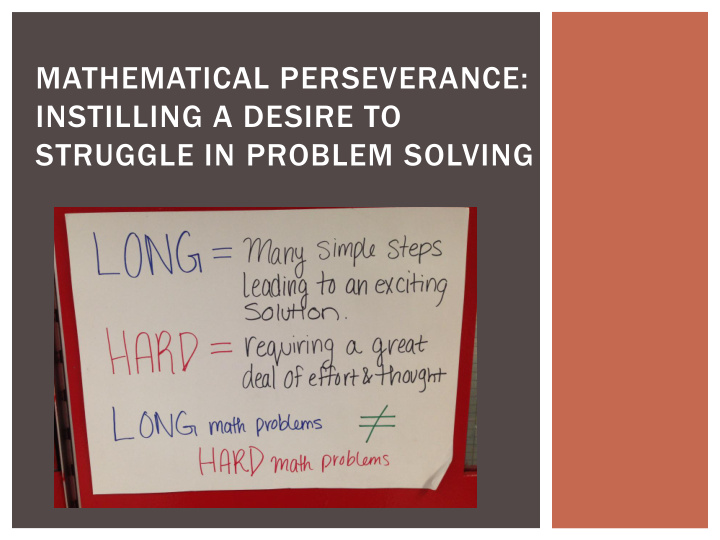



MATHEMATICAL PERSEVERANCE: INSTILLING A DESIRE TO STRUGGLE IN PROBLEM SOLVING
CAN YOU GUESS THE RULE?
CAN YOU GUESS THE RULE? 4, 6, 8 10, 12, 14 Guess the rule that applies to both sequences OR You can guess a set of three numbers you think follows the rule
WHAT IS GRIT? GRIT: : Tenacity; perseverance; the ability to never give up; resilience
HOW DO OUR STUDENTS VIEW GRIT? Student Video
WHAT DID YOU NOTICE? In groups of 4 people, discuss your reactions: “I saw…” “This made me think about…” “I wonder…”
PERSONAL EXPERIENCES Can you think of a situation where grit has contributed to a personal success? Where do you think not having grit has held you back? Does your level of grit vary depending on the setting? (academic/sports/etc) How do you think your level of grit has changed over time? Share Out: How did you develop your grit???
GRIT RESEARCH: OVERARCHING THEMES Fixed mindset vs Growth mindset Instilling confidence in our students Create and monitor controlled frustration
GRIT IN OUR CLASSROOMS Make it the theme of your classroom Teach vocabulary/concepts What is “trying”? Processing time can vary Wrong answers can be useful Grit test “I showed grit when….” Share your own personal experiences with students
GRIT TEST
GRIT IN OUR CLASSROOMS Make it the theme of your classroom Teach vocabulary/concepts What is “trying”? It’s ok to take a longer time to process Wrong answers get you closer to the right answer Grit test “I showed grit when….” Share your own personal experiences with students
GRIT POSTER
GRIT IN OUR CLASSROOMS Make it the theme of your classroom Teach vocabulary/concepts What is “trying”? It’s ok to take a longer time to process Wrong answers get you closer to the right answer Grit test “I showed grit when….” Share your own personal experiences with students
GRIT IN OUR CLASSROOMS Rewards: Make them internal vs external View failure as a learning opportunity Applaud wrong answers Ask what can we learn from a mistake
GRIT IN OUR CLASSROOMS Problem Solving Tactics Long homework problems Rigorous assignments: Delta Math Give them a destination Work independently before group work Counter-intuitive solutions Authentic problems that exist in our world
GRIT IN OUR CLASSROOMS
GRIT IN OUR CLASSROOMS Instill confidence Sense of community Allow struggling students to be leaders Positive reinforcement BCSM: Our own “NCTM” led by students
GRIT IN OUR CLASSROOMS Offering choice Project presentation method and topic 12-Diamond homework Choice of problems on Exams Students create challenge problems for tests
GRIT IN OUR CLASSROOMS Provide support when students are stuck Provide a 1 st step List available resources Study Groups
REFLECTION What resonated with you? What’s 1 thing you can implement in Monday’s class?
INTERNATIONAL FINDINGS: Strategies: Model Grit Psychological Intervention Motivation Comes from the family Why do they give up? Students are lazy There is a psychological obstacle Students are afraid “Habits are created by culture”
INTERNATIONAL FINDINGS: Strategies: Teach how to study math Make it a habit to study at home Emphasize checking work Motivation Sense of achievement Important for university entrance exam How is grit developed? Home life has the greatest impact Lots of homework Success stories of family members or celebrities
KEY TAKEAWAYS Our classrooms should reflect the Growth Mindset Get students to look at failure as a learning opportunity Push students to go outside their comfort zones Focus on intrinsic rewards like pride and accomplishment Use extrinsic rewards as a compliment for showing grit
WANT TO READ MORE? CHECK OUT THESE RESOURCES… Books Mindset by Carol Dweck How Children Succeed by Paul Tough Closing the Attitude Gap by Baruti Kafele The Motivated Student by Bob Sullo Fostering Grit by Thomas Hoerr Articles The Significance of Grit by Deborah Perkins-Gough Good Failures by Thomas Hoerr Growing Capable Kids by Carol Ann Tomlinson Havens of Resilience by Nan Henderson Getting Beyond “I Hate Math!” by Lisa Medoff Afraid of Looking Dumb by Mark Jacobson Contact us: Jaffe.elisabeth@bcchsnyc.net cogan.ruth@bcchysnyc.net simon.brooke@bcchsnyc.net wegener.ashley@bcchsnyc.net
Rate this presentation on the conference app! www.nctm.org/confapp Download available presentation handouts from the Online Planner! www.nctm.org/planner Join the conversation! Tweet us using the hashtag #NCTMNOLA
Recommend
More recommend